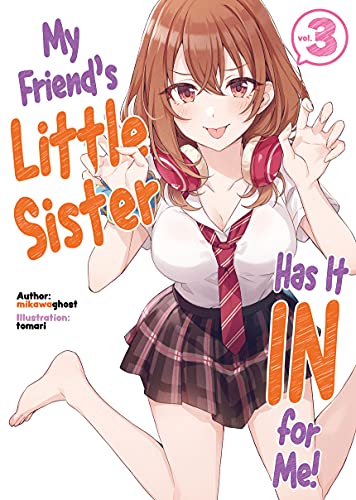By mikawaghost and tomari. Released in Japan as “Tomodachi no Imouto ga Ore ni dake Uzai” by GA Bunko. Released in North America by J-Novel Club. Translated by Alexandra Owen-Burns.
Someone needs to tell Japan that “having the rest of the cast being creeped out about the appalling character” is not a get out of jail free card for everything the character does. I’ve said in the previous books that the shotacon tendencies of Sumire are not funny but awful. Well, she’s the main character of this book, and so we get a lot more of it than even the previous two, and it’s still awful. Saying that a guy would be the perfect husband if only he were 5 years old is not a “LOL” moment. So be aware as I write the rest of this that this is a big black mark, and made me not enjoy this book nearly as much as the previous two. That said, I’m still reading it, because I do like the cast and the romantic comedy situations. With, well, one exception. Fortunately, this is not We Never Learn, so the teacher has precisely zero chance of winning the romantic sweepstakes.
We pick up right where the cliffhanger left off, as Sumire begs Akiteru to marry her. As expected, her family has decided enough is enough, and is going to arrange marry her soon… which means she won’t be able to draw anymore. This is basically the only reason Akiteru agrees to the scheme. After some “wacky” date situations, which I will not go into as they are dumb, a trip that’s supposed to be to the beach becomes a trip to her remote mountain village, where her father wants to meet Akiteru… and force them to get married immediately. Can they possibly get around the marriage ceremony with a 100% success rate? Can Iroha continue to try to cleverly juggle all these relationships in the air, given sempai is a dense MF and won’t do it for her? And can Mashiro finally admit she’s secretly their star writer?
Again, this series leans pretty hard on the Higurashi pastiche. Their game is subtitled “When They Cry”, and Sumire’s home village essentially turns out to be Hinamizawa, complete with terrifying elders and obscure rituals. Having already mentioned the volume’s big weaknesses, I do want to applaud its really good moment, when Mashiro’s editor (who we meet here, ad boy does it take some fancy footwork to explain her presence) points out to Akiteru that he needs to be able to offer his fellow game creators a reason to stay on with him, or else they’re going to look for other opportunities. What can he personally offers them? (Other than, of course, being the romantic lead who has no idea half the cast are in love with him.) It’s not a question that’s answered here, but I do appreciate it was brought up. Iroha also remains quite enjoyable, a bit less “annoying” than the first two volumes, probably as she’s trying harder to have him “get” her feelings.
That’s unlikely to happen soon, and a cliffhanger means we don’t even get this one resolved in one volume. Still, hopefully it won’t take up all of Vol;. 4. I think two volumes starring Sumire is two too many.


Speak Your Mind